Geralt of Rivia’s face has come a long way since its first appearance in 2007, when he looked like a grumpy parsnip. The Witcher 2 gave him better hair, high-res stubble and keen eyes. In The Witcher 3, his face is lined, grey and craggier than Daniel Craig’s scowlface. That sharp gaze has dulled. He has the look of an RPG hero who’s about to embark on the biggest adventure of his life and knows he’s going to have to kill a lot of things before bedtime. Will he make it through alive?
Ominously, CD Projekt RED says that The Witcher 3 will wrap up Geralt’s story, and his survival prospects don’t improve when you consider the scale of the threat he faces. The northern realms are being ravaged by a bolshy empire and hassled by the titular Wild Hunt – a cavalcade of supernatural horsemen laying waste to every town they find. They’ve popped up throughout the series with prophecies of doom and gloom, but terrorising a country is a new level of naughtiness for them. You’ll have to travel the vast open world and visit kings, peasants, witches and warlocks to find out what’s going on and put a stop to it.
That’s an epic job, but CD Projekt RED insists that the game will weave a personal story through the chaos. “The main theme of Wild Hunt is Geralt’s journey through this world,” says CD Projekt RED’s Michal Platkow-Gilewski. “The world itself hasn’t changed – it’s still dog-eat-dog, it’s still full of strife, and political turmoil. It’s about you and how you handle these topics. You’re the monster hunter and frequently it’s up to you to determine who the monster is – and some of the times it’s not your usual suspect.”
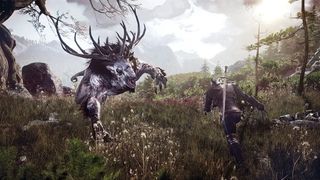
Don’t panic if you don’t know Kaedwen from Redania; this story will be more self-contained than previous games. You won’t need to know the history of the second game’s Scoia’tael or the story of King Foltest from the first game (though there will be an encyclopedia in the game, if you choose to peruse it). You learn about The Witcher 3 by exploring the world, and asking questions of those living within it. You’re a fish out of water, but so is Geralt; you muddle through and fix what you can. “He’s like a gunslinger in the west, like a ronin, he’s a wandering problem-solver, a fixer, a bounty hunter who deals with every layer of society.”
You’ll face some dark decisions along the way. Think of The Witcher 3 as an HBO Zelda that’s muddier and bloodier than Dragon Age and Skyrim. It has the complicated political wrangling of Game of Thrones, but splices tales of feudal angst and courtly scandal with monster stories borrowed from the strangest corners of European folklore. Those real-world roots give the mythology authenticity and lets the series combine supernatural weirdness with earthy realism in ways you’d never see in a faux-Tolkien universe of singing elves and hard-drinking dwarves.
The results can be unusually twisted. Take the Botchling, a sinister new creature CD Projekt RED has revealed to OXM. “Botchlings are creatures that come as a result of miscarriage,” says Platkow-Gilewski. “When a pregnant woman miscarries her baby and abandons their body without giving the child a name, there’s a chance that the child will come back to life in the form of a Botchling.”
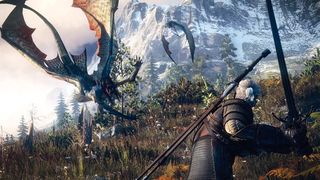
A Botchling forms the important part of a quest concerning the wife of a powerful warlord who lost a child. The child, in monstrous form, is attacking and drinking the blood of locals – Geralt is hired to help. “The choice here is to either convince the warlord to accept his baby and take it to the place where a special dispelling ritual is going to be conducted, or Geralt can kill it and set off with the bounty. As you might expect, both have their consequences and fit into the broader story. The choice is always left to you.”
Sign up to the GamesRadar+ Newsletter
Weekly digests, tales from the communities you love, and more
Maybe those different outcomes seem unsatisfactory to you. Better get used to that. Happy endings are hard to come by in The Witcher, and choices you make for the right reasons can backfire in challenging ways. You’re free to try to dodge issues, but even this can have repercussions.
“Players are quite accustomed to choosing between ‘this or that’ and then facing the consequences of these choices,” says Platkow-Gilewski. “In Wild Hunt, inaction is also an option. Imagine this: you’re going through a forest, you see a lonely hut and a bunch of thugs trying to get inside. If you decide to get closer and investigate, you’ll probably get into a fight and then you’ll have to choose whether to kill the bad guys or spare them. Now imagine that if you decide to just run by, next time you’re there, the person in that hut might be dead. This might have been a quest-giver, or a secluded merchant. This mechanic plays a big role in the morally tough choices you’ll make in the game.”
Of course, in some cases choice goes out the window and you have to resort to Geralt’s favourite problem-solving approach: hit it with swords. But steel or silver? Geralt always wears both. Steel is good for hacking up men, and silver is good for injuring magical enemies like ghosts or troublesome Botchlings. Geralt is a master swordsman, and that’s represented by some new combat moves. He can pirouette and parry and chop arrows out of the air, as well as shoot charging foes down with a miniature crossbow.
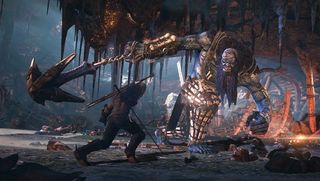
For more spectacular kills, you can make use of Geralt’s magical talents, which carry over directly from The Witcher 2. Burn enemies with a spray of embers, or blow them backwards with a push spell a Jedi would be proud of. Yrden lays a magical trap on the ground and the vital Quen spell can deflect a blow. You can use these spells to exploit the environment and finish a fight quickly. Use your fire spell in the gaseous southern swamps and you’ll turn the lingering methane into an impromptu fart-bomb – an awful death.
The new graphics engine rewards skill with an impressive show of gore. Limbs fly, and blood pools, glistens and clouds up water. Fire your push ability over water and you’ll see violent ripples trace its path. Blast a bandit’s shield with fire and it’ll glow red then spend the next minute cooling back down. The Witcher 3 has looked stunning in the guided demos CD Projekt RED has showed us so far, but we’ll have to play it to see if it really improves on the imprecise roly-poly-stabby-stabby combat of the second game.
The Witcher 3 has certainly improved in one essential area: horses. You can ride them now, and really should if you don’t want to spend days of your life hiking. You can tether the heads of monsters you’ve killed to the saddle, and chop down enemies mid-gallop. You can also sail, and explore new subterranean areas. “We have a big underwater section in the game,” Platkow-Gilewski explains. “Geralt can dive, and this opens up an entirely new section of gameplay that was previously unavailable.”
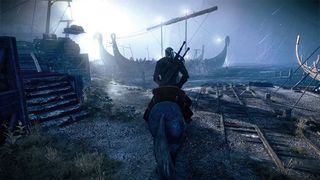
Platkow-Gilewski has more secrets to tell us about the places we’ll get to visit. “You know that Witchers were trained in Witcher schools, right? In Wild Hunt, you’ll get to explore the most legendary of these schools, the ruins of Kaer Morhen, where Geralt was trained. We’ve shown the location in one of our trailers, so I think it’s high time we tell you that it’s not only for aesthetic reasons – it’ll actually play a big part in the game.”
That ought to give us some rare insight into our reticent hero’s youth, and tell us more about the Witchers, who remain mysterious even three games into the series. Taken as children, they are forged into monster hunters through training – and a chemical regime that mutates them into long-lived warriors. They lose their childhood, their ability to have children and are generally feared for their strange appearance and alarming stabbing skills.
The big question is whether the second playable character in The Witcher 3 is also a monster hunter. At first glance Ciri looks like a female Geralt, complete with pale hair and the characteristic scar across her left eye. CD Projekt RED is coy about her precise identity. “We see Ciri as this living weapon who everyone wants to get a piece of,” says Platkow-Gilewski. “She has immense power and is capable of tremendous things, dark forces are on her tail and Geralt is also looking for her. At the same time, we thought it would really benefit the experience if we could let players see the nature of things from her perspective.
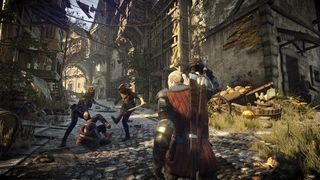
“It’s still a game about Geralt roaming the open world, though. We see Ciri’s role as a narrative device more than a key gameplay thing. Still, she’s a fully developed character with unique skills, like the ability to blink (read: teleport).”
A playable woman marks a big change for a series that let you sleep with them to unlock collectible cards in game one. In this respect, the series has undergone a gradual shift in tone. There’s always been coarse tavern banter – the world is full of bastards – but the assumption that mature fantasy = boobs has faded. The series has grown up a little more with each entry, and The Witcher 3 is set to benefit from that trend.
The most dramatic shift of all is one of scale. The games have always been globe-trotting adventures, but only realised through insulated hub locations. Wild Hunt is a continuous open world that you can explore almost entirely without loading screens. There is fast-travel, which lets you zip to places you’ve discovered, but areas you haven’t visited aren’t accessible in this way. It encourages exploration, and exploration is dangerous.

“In Wild Hunt, the monsters don’t scale – which means that you’ll traverse regions you might not be ready for, if you’re not prepared or not properly equipped,” says Platkow-Gilewski. “This means you’ll have to utilise everything at your disposal to survive, especially early on. Alchemy, crafting and developing your combat potential will have to be something that you put much attention to. You’ll have to create synergies between items or skills if you want to venture deeper into certain places.”
The most complex systems in The Witcher are tied to preparation, and alchemy is a key part of that. Geralt can kneel and meditate for hours at a time – an effect accompanied by a beautiful time-lapse sequence that shows the sun hurtling through the sky, casting strobing shadows across the landscape. During that period you can throw together ingredients you’ve foraged to brew potions that boost your combat faculties. In previous games you’d brew pints of the stuff and then wander around trying to kill tough enemies before the effects wore off. In The Witcher 3, Geralt has learned to brew shots. If you see something horrible coming, you can take a swig of the drug you need and get the effects right away. CD Projekt RED hopes that this makes the alchemy skill tree as appealing as magic and sword-fighting.
Alchemy ought to be especially useful in places such as No Man’s Land – a desolate swampland trashed by recent wars. Humans only survive here in scattered settlements, and the real estate they’ve abandoned has now been claimed by monsters. A trio of horrible witches called the Crones dominate the region, but you’ll also find Drowners – ghouls risen from corpses thrown into rivers throughout the land. There are also werewolves – it wouldn’t be a good fantasy game without a werewolf – and these are affected by the day-night cycle. Expect a fiercer fight from some creatures when you take them on at night.

That’s just one area. You’ll also visit the wintry Skellige Islands, which look a bit like Skyrim and are inhabited by some very grumpy Nordic warriors. You’ll be using your boat a lot here to visit “distant pirate islands far away from civilisation”.
When you tire of snowy wastelands, you can retreat to The Witcher 3’s biggest city: Novigrad. It’s a huge port city with distinct districts and dozens of hidden side-quests. You can get involved with the political situation in the courts, hear news from locals in the taverns or hang out with spies in the bustling fish markets. There are quests everywhere, and CD Projekt RED is trying its best to ensure that none of them are typical RPG fetch-me-something missions.
Instead you’ll be doing lots of Witcher work. In the past it’s been easy to forget that Geralt hunts monsters by trade, but it’s a big part of The Witcher 3. Different regions will hide legendary beasts you can track for the game’s best rewards. You’ll have to search for signs of the creature by scanning attack sites for clues, which handily glow when you activate Geralt’s Witcher vision. These work a bit like Batman: Arkham City’s crime scenes – examine the right clues to see ghostly sequences play out, representing the working of Geralt’s expert imagination. Found a naked man hanging out of a tree? Geralt will figure out the trajectory that put him there and deduce the size and power of the monster involved, like a medieval Sherlock Holmes.
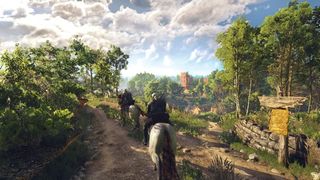
You sometimes need to research the creature you’re hunting before trying to kill it, but even if you’ve crafted the perfect sword for the task and chugged a cask’s worth of magical hooch, things can get difficult. Such enemies – like the giant CD Projekt RED has shown – can use their environment against Geralt. The giant can pick up a nearby anchor and start using it to splat you from range, for example.
The Witcher 3’s scope is dizzying. Above land, underground, underwater: there are quests to take and monsters to kill everywhere. No wonder it’s taking so long. Wild Hunt has been delayed (again) to the summer while the team adds some final polish, but the results could be spectacular – especially if it nails that sense of an intimate story set against a backdrop of boundless explorable land.
“We see it like this: games usually either give you a really nice open world or a great story, but set in a closed world. We’ve worked super hard to give you both,” says Platkow-Gilewski. “On one hand, the open-world mechanic you know and love; on the other hand, the novel-quality plot Witcher games are known for.” The last chapter is coming, so get meditating, and set an alarm clock for 19 May.
The official source for everything Xbox One, Xbox 360, and Xbox Series X. We're also a magazine, covering all things Xbox in the UK and the US. Originally established in 2001, the magazine was discontinued in April 2020.

Meet the Dead Boy Detectives: Inside the comic book origins of Netflix's brilliant new Sandman spin-off

Steam's most-anticipated city-builder is set to make millions, but for Manor Lords' CEO, "I don't think the money weighs that heavily"

Manor Lords release time – the countdown to Steam's most anticipated city builder is on
Most Popular




